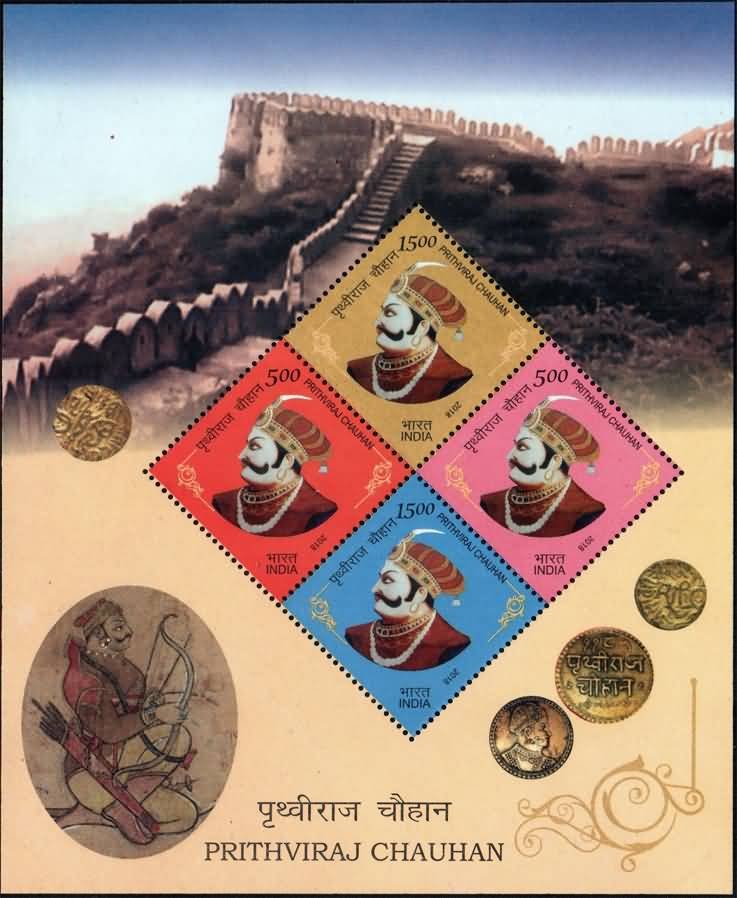Prithviraj Chauhan

Technical Data
| Date of Issue | April 28, 2018 |
|---|---|
| Denomination | Rs. 40 |
| Quantity | 500,000 |
| Perforation | 13¾ x 13¾ |
| Printer | Security Printing Press, Hyderabad |
| Printing Process | Wet Offset |
| Watermark | No Watermark |
| Colors | Multicolor |
| Credit (Designed By) | Smt. Alka Sharma |
| Catalog Codes |
Michel IN BL191 Stamp Number IN 3027 Yvert et Tellier IN BF178 Stanley Gibbons IN MS3498 |
| Themes | Coins | Commemoration | Famous people |
Prithviraj III (reign 1178–1192 CE), popularly known as Prithviraj Chauhan or Rai Pithora was an Indian king from the Chahamana (Chauhan) dynasty. He ruled Sapadalaksha, the traditional Chahamana territory, in present-day north-western India. He controlled much of the present-day Rajasthan, Haryana and Delhi; and some parts of Madhya Pradesh and Uttar Pradesh. His capital was located at Ajayameru (modern Ajmer), although the medieval folk legends describe him as the king of India’s political Centre Delhi.
Prithviraj was born to the Chahamana king Someshvara and queen Karpuradevi. King Someshvara died in 1177 CE when Prithviraj was around 11 years old. Prithviraj, who was a minor at the time, ascended the throne with his mother as the regent. During his early years as the king, Prithviraj’s mother managed the administration, assisted by a regency council. In 1175 CE, Muhammad of Ghori crossed the Indus River and captured Multan. In 1178 CE, he invaded Gujarat, which was ruled by the Chalukyas (Solankis). Over the next few years, Muhammad of Ghori consolidated his power in the territory to the west of the Chahamanas, conquering Peshawar, Sindh, and Punjab. He shifted his base from Ghazni to Punjab and made attempts to expand his empire eastwards, which brought him into conflict with Prithviraj Chauhan.
During 1190–1191 CE, Muhammad of Ghori invaded the Chahamana territory and captured Tabarhindah (identified with either Bhatinda or Sirhind). When Prithviraj learnt about this, he marched towards Tabarhindah with his feudatories, including Govindaraja of Delhi. Ghori’s original plan was to return to his base after conquering Tabarhindah, but when he heard about Prithviraj’s march, he decided to put up a fight. He set out with an army and encountered Prithviraj’s forces at Tarain. In the ensuing battle, Prithviraj’s army decisively defeated Muhammad of Ghori. Muhammad of Ghori was injured and forced to retreat. After defeating the army of Muhammad of Ghori, Prithviraj Chauhan was asked to attack the retreating army but in the true Rajput tradition, Prithviraj refused to do so as it did not conform to the fair war rules.
Ghori returned to Ghazni and made preparations to avenge his defeat. He gathered a well-equipped army of 120,000 select Afghan, Tajik and Turkic horsemen over the next few months. He then marched towards the Chahamana kingdom via Multan and Lahore, aided by Vijayaraja of Jammu. Ghori formed four divisions, with 10,000 archers each. He kept the rest of his army in reserve. He ordered the four divisions to launch a surprise attack on the Chahamana camp, and then pretend a retreat. At dawn, the four divisions of the Ghori’s army attacked the Chahamana camp, while Prithviraj was still asleep. After a brief fight, the attackers pretended to retreat in accordance with Ghori’s strategy. Prithviraj was thus lured into chasing them, and by the afternoon, the Chahamana army was exhausted as a result of the pursuit. At this point, Muhammad led his reserve force and attacked the Chahamanas, decisively defeating them. Prithviraj Chauhan fought bravely in the battle but got caught near the Sarasvati fort (modern Sirsa). Prithviraj Chauhan died in 1192, with his death a period of bravery, courage, patriotism, and principles came to an end.
